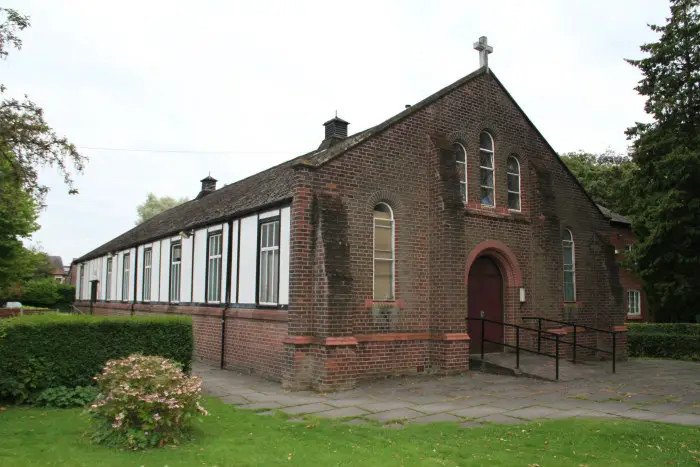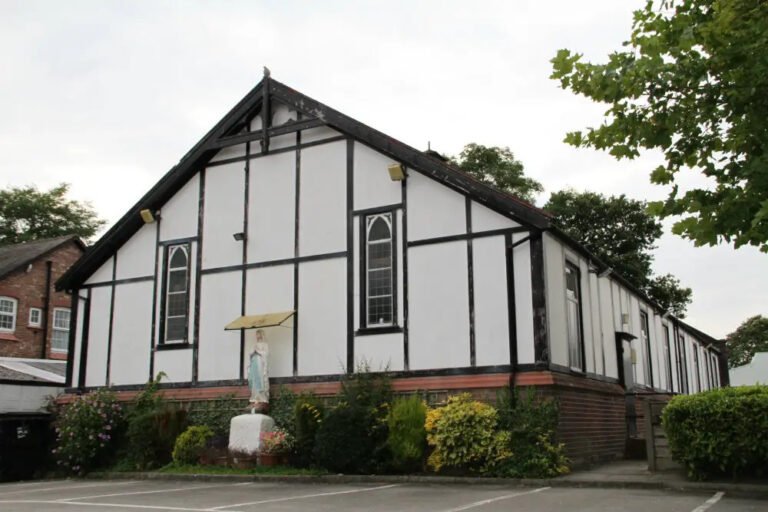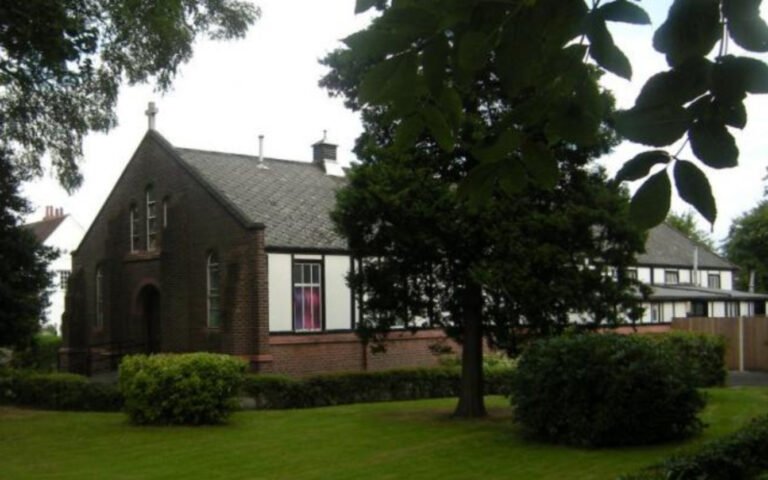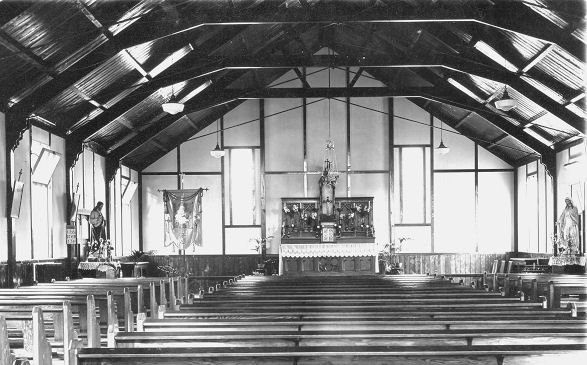ST HUGH AND ST JOHN'S RC CHURCH

On the 13th of December, 1931, a church was opened and dedicated to St Hugh of Lincoln in West Timperley. It was not quite what parishioners might have wanted, as it was designed as a temporary building, a “stop-gap” intended to stand for about ten years, built of “light wood and asbestos frames on brick footings”.
The interior was quite plain and it lacked a centre aisle, so that brides refused to hold their weddings there, but went back to the first church in the area, St Vincent’s in Altrincham (first established in 1847). Parishioners in general, however, welcomed the church very gladly.They had waited a long time. There were few cars in those days, and people had had to walk in all weathers every Sunday to either St Vincent’s or St Joseph’s in Sale to attend Mass. Broadheath was a thriving centre of employment, and a great many houses had been built in recent years. A church had long been needed by the growing population of West Timperley.
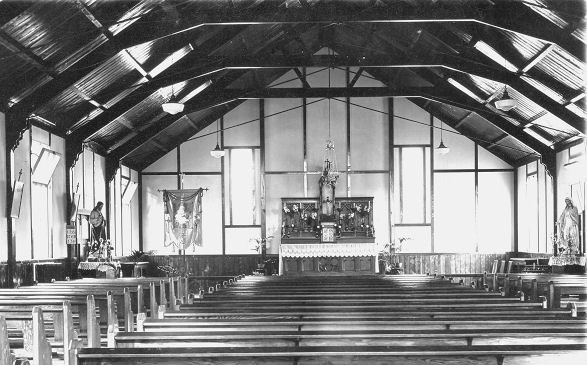
Happily, in 1927 a big, run-down Victorian property, known as Timperley House, with a useful piece of land near the corner of Park Road and Manchester Road, had come up for sale. Canon Hugh Welch of St Vincent’s, anticipating further growth of housing in the Broadheath and West Timperley areas, approached Bishop Hugh Singleton, arguing that this would make an ideal site for a church. The Canon’s plea was answered, and the house bought for £1,700. In consequence, many Catholics from further away purchased houses in its vicinity.
Father Peter Burke
In order to provide funds for the building of a church, a campaign of door-to-door fundraising and collecting signatures on a petition to the Bishop was just getting started when Father Peter Burke was appointed as the priest of the new parish. He arrived to find a parish with no church and no presbytery. He was a little frail in health, and Timperley House was not considered fit to live in. So some parishioners housed him temporarily on Bloomsbury Lane, while another couple offered their house for the celebration of Mass. Fr Peter was very aware that the authorities were not convinced the need for a church in this area would last, so the plans he proposed to them were pragmatically for a “semi-permanent” structure. This was agreed by Bishop Hugh.
It was foreseen that, when building began,o Bloomsbury Lane wuld be too far from the site, so Parishioners set to work in Timperley House, making some small improvements and, more significantly, knocking two rooms together to serve as a chapel. Fr Peter Burke moved in to live there, despite its sad general condition, damp and lack of adequate heating. The “chapel” was greatly enhanced with a carved wooden and gilded reredos screen and with brass vases – all made by parishioners with appropriate skills. When a piano was acquired as well, the chapel developed a family atmosphere. It held its first baptism in November 1930 and served well during the time of the new church’s construction, until it was complete and opened in December 1931. The dedication of the church to St Hugh perhaps owed something to the names of both Canon Hugh Welch and the Bishop Hugh Singleton.

The plain interior of the church was soon transformed by the installation of a new and larger reredos screen, candlesticks and statue stands, all carved in wood by local craftspeople. The statue of St Joseph, which occupied one of these stands, was donated by local families. There was a handsome stone font (origin unknown) and a choir loft with an instrument – probably a harmonium.
Sadly, however, there was still no presbytery. In the poor conditions of Timperley House, Father Peter’s health deteriorated and he was obliged to retire.
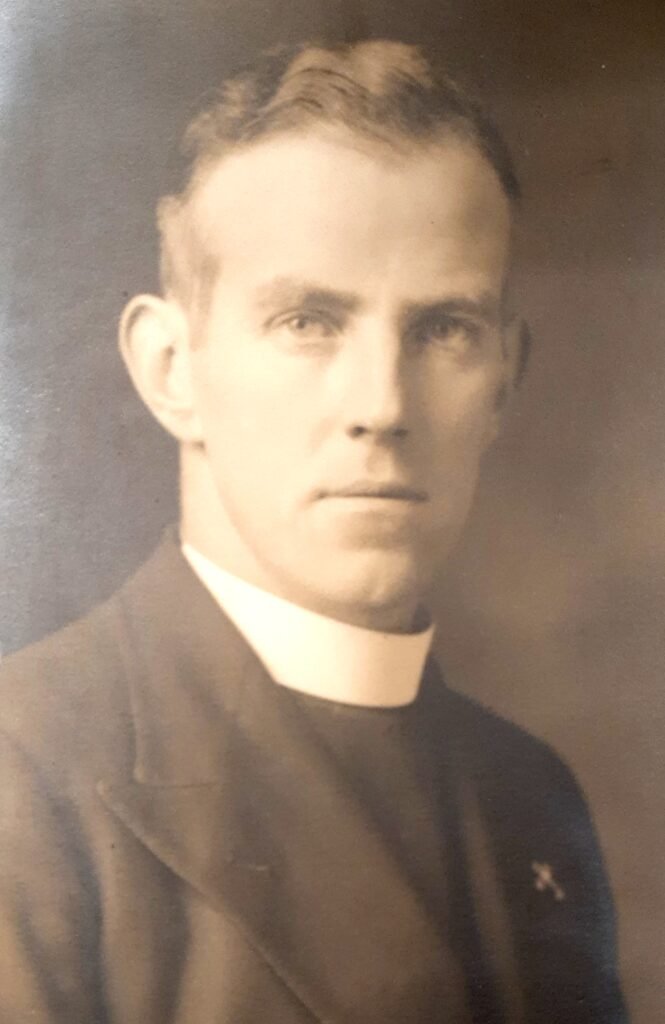
Father Thomas Butler
In 1932 a younger and more vigorous priest was appointed to the parish: Father Thomas Butler. Impetuous, and determined to put the parish on the map, Father Thomas was to serve as priest here for 20 years. He is still remembered by older parishioners today. He certainly left his mark on the parish.
He had a presbytery built, though this was much smaller than the one we have today, lacking the large front extension which would be added in future years. He had Timperley House demolished, and the land made into equal halves of lawn and hardstanding. He exhorted young parishioners to marry in their own parish, and the first wedding was held in 1933.
The housing developments in Timperley multiplied at a great rate in the early 1930s, with eleven new estates built. The only Catholic school in the area, St Vincent’s, was bursting at the seams. Extra land was purchased to increase the St Hugh’s site, with a view to establishing a small new school. There were plenty of children who could not get a place in St Vincent’s, so they were taught and prepared for their First Sacraments by a lady parishioner, a teacher at St Vincent’s, who taught them in her house on Hawthorn Avenue.
All the young girls had “walking-out frocks” and wore these for Corpus Christi and other processions. They had a May Queen and a procession on the first Sunday of May. Father Butler liked to visit Lourdes and had a great devotion to Our Lady. He built a grotto of Our Lady of Lourdes, with a statue of St Bernadette.
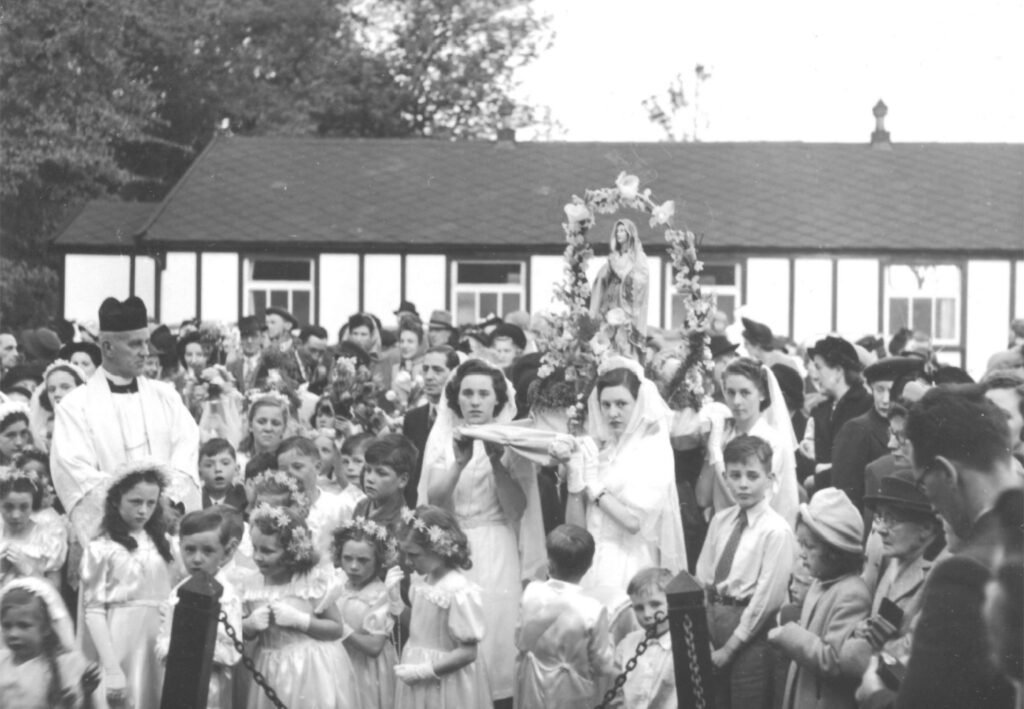
Father Butler had a great sense of fun and enjoyed socialising and playing jokes on his altar boys. Since it was taking so much time to attain the necessary planning permission for a new school, he had a large timber-framed hut built on the land which could be (and was) used for fundraising events. In it were held concerts, whist-drives, dances, parish meetings, and those of the new conference of Saint
Vincent de Paul (founded in 1933 through Fr Butler’s encouragement), the Scouts, and the Union of Catholic Mothers.
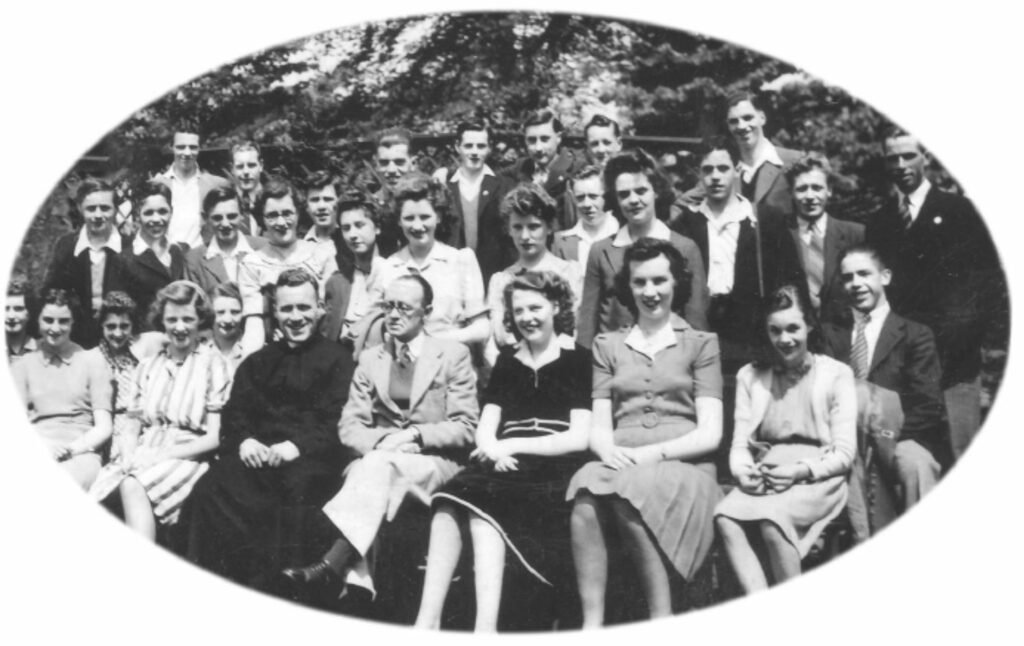
The SVP found a great deal to do during the financial depression of the thirties. The parish, prompted by the persuasive preaching of Father Thomas on “seeing Christ in the poor”, helped by placing contributions in a “poor box” at the back of the church. The men who served in the SVP got plenty of exercise, visiting and helping people as far away as the new Broomwood estate, without the aid of cars. In 1938 a Youth Club was founded and soon developed an enthusiastic football team known as the White Swans. The club was for boys only, until pressure from girls brought about a change, and they were allowed to join from 1941. Similarly, the Scouts, of course, initially recruited only boys, but Guides and Brownies soon played their part in the hall’s activities. (The SVP, however, did not include ladies until 1971.)
Further Challenges
Timperley Village, originally very small, had by this time expanded with the spread of housing development. A need had arisen for another new church. To begin with, Father Butler solved the problem, with the help of a succession of curates, by celebrating Mass in the Church of England Community Rooms (now the Village Club) on Stockport Road. He had an unreliable car by this stage and attempted to make the journey there by its means. It broke down so many times on the way there, however, that parishioners lucky enough to have cars put together a rota, and drove their parish priest to the venue for Mass.
There was an increasing need still for a new school. St Vincent’s school had become more than overcrowded. There had to be evidence of 250 children being in need of education before a new school would be considered, and even if this figure were reached, there was great hostility to Catholic schools. Requests were turned down, even if parishes offered to fund them 100% themselves. All the efforts in Timperley resulted only in the founding of a new state school on Frieston Road (now Park Road School), to which Catholics were summarily directed.
The Bishop made an appeal to the government for a small Catholic school in West Timperley, along with an expansion of St Vincent’s. It was rejected. Similar events were happening throughout the country, and this led to the formation of the Catholic Parents and Electors Association (CPEA). A little progress was made, thanks to local members of this group and to St Hugh of Lincoln.
CPEA members met with Leslie Lever MP, a Jewish man who worked for social welfare in Manchester and who understood the need for Catholic faith schools. He had been asked firstly to support a St Hugh of Lincoln Church in Stretford. In turn he had asked, “Who was this St Hugh?” He was duly informed that St Hugh was a mediaeval bishop who, when Jews were being persecuted, stood between the Jews of Lincoln and a stone-throwing mob. “I will do anything for this brave man!” Leslie Lever is reputed to have said. “We need more St Hughs.”
With his help, plans were set in train for a small school on the land currently occupied by Father Butler’s timber-framed meeting hall. Sadly, however the Chester county authorities stalled its progress, and then a real blow struck when legislation came into force which made the proposed site ineligible, because it was too small to provide sufficient playground area. Undefeated, Father Butler set about a search for alternative land.
In 1939 a plot of land was purchased for £1,570.5s. It lay on the far side of the Bridgewater Canal but beside Park Road (where St Hugh’s School stands today). Things were beginning to look more promising, when World War II broke out and changed everything. All building work ceased.
There was considerable anxiety at the prospect of the government (the Ministry of Agriculture and Fisheries) requisitioning the land. It was hastily decided to turn the land into allotments. So allotment holders’ secret rents (the secrecy legally necessary to ensure the parish’s title to the land) provided a small income for the parish and the land was not requisitioned, although it did receive one of Timperley’s very few bombs. It was just as well that a school had not yet been built. Many more bombs, of course, fell on the industrial area of Broadheath. There was a great need of fundraising for the Red Cross.
The meeting hall at St Hugh’s was once again put to use, for pantomimes and concerts and other events to raise funds. One evening in June 1944, in the Regal Picture House (on the site of Roberts House) the audience was informed of the coming of “evacuees” (a new word to everyone), unaccompanied children from London, who would need to be housed with families. Lots of people in the parish volunteered and schooling for many evacuated Catholic children in the area, since there was no room at St Vincent’s, was provided in Father Butler’s hall.
After the war there were large numbers of “war-babies”. This led to a national increase in the building of council houses and of schools to accommodate the increasing numbers of children. St Vincent’s had struggled so long with overcrowding, that its buildings were condemned as “dangerous and insanitary”. Father Butler threw himself into a new fight for a school.
In 1952 he went door-to-door round the parish houses, personally canvassing for support and collecting contributions. On the night of January 14th he was delighted to have gathered £14! Unfortunately, however, the following evening he collapsed in the presbytery and despite best efforts, his life could not be saved. After 20 years of passionate dedication to his parish and its people, Father Butler left this world in 1952. He was greatly mourned and missed. Today, you can visit his grave at Hale Cemetery.

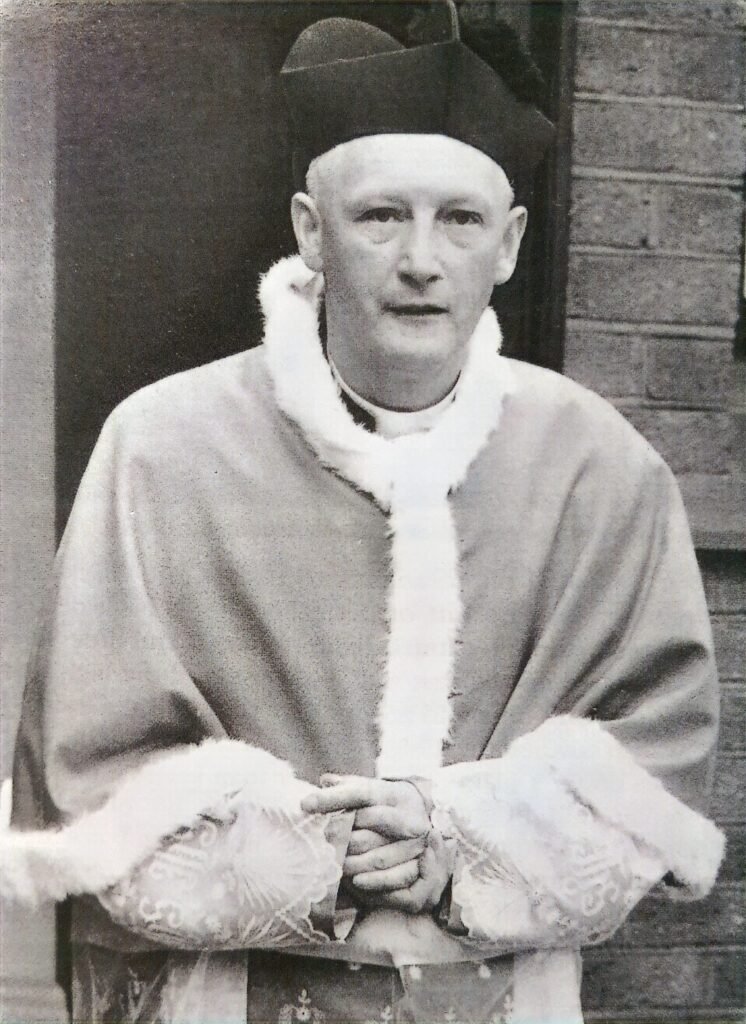
Father Joseph Briscoe
Father (later Canon) Briscoe replaced him. He proved to be a gentle-mannered priest, and far more careful and considered in his approach than Father Butler. Yet he did not lack a certain steeliness beneath. He made changes, importantly to the presbytery, extending it considerably. The “temporary” church of St Hugh of Lincoln, which had already lasted twice as long as originally envisaged, was given a new lease of life, by internal painting in lighter colours, and some re-arrangements of furnishings inside. Father Briscoe refrained from spending money on the structure of the church, however, preferring to acquire things which could be relocated into a new and permanent church whenever this was built.
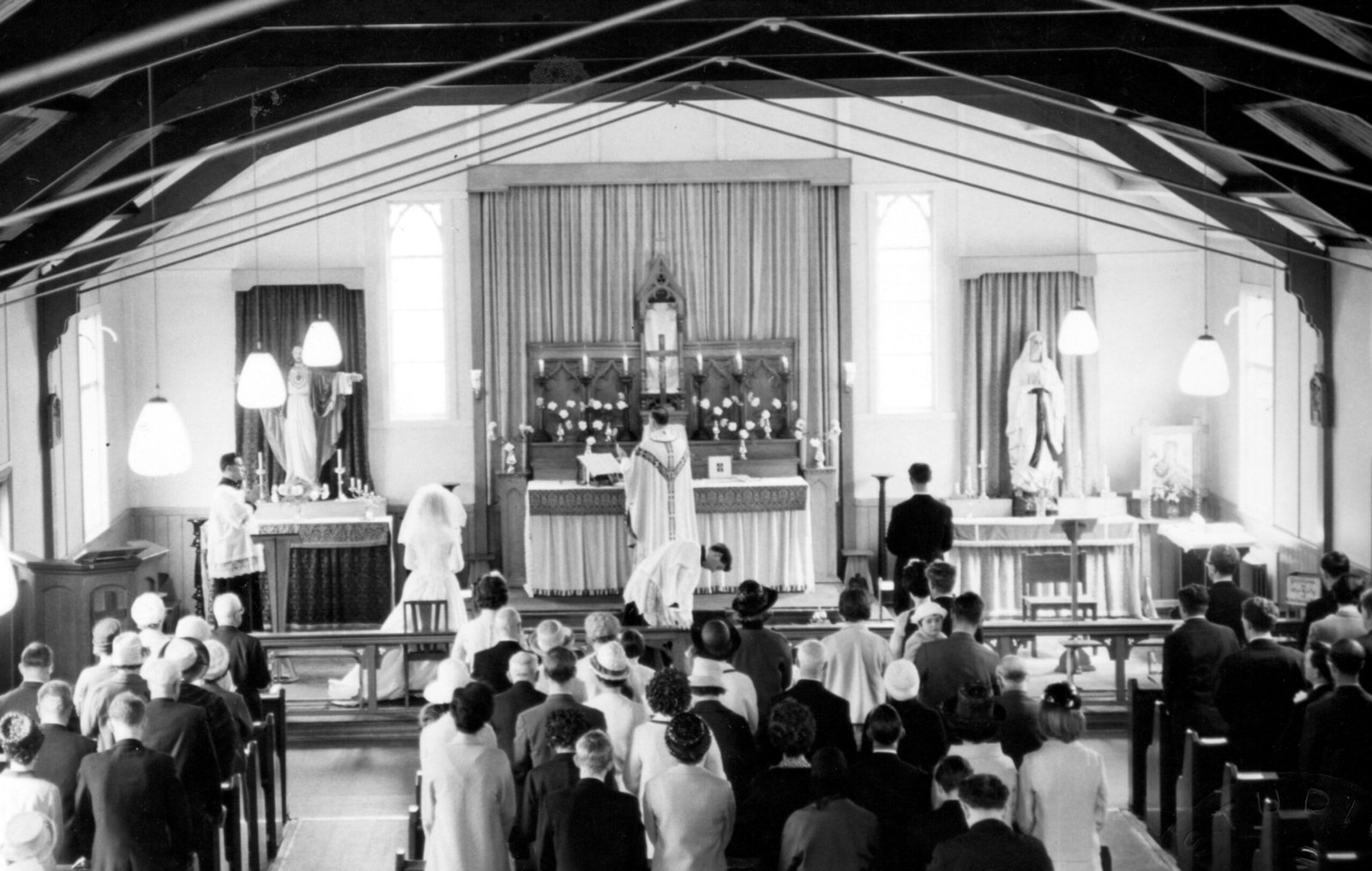
Perhaps the most notable of these was a set of Stations of the Cross, carved by the Italian artist, Romanelli of Genoa, to an Englishman’s design. They cost £300 which was raised by appeal and by the sponsoring of individual Stations by parish families or individuals. These have been re-gilded a number of times by a talented parishioner, and still hang in our church today.
Father Joseph could see only too well that his church was too small for all the area’s Catholics. The Village had grown again, with further private house-building and the continuing development of the Broomwood and Grange estates. The Parish Rooms were by now totally inadequate. Timperley Village clearly needed a church and a priest of its own.
Fortuitously, in 1957 a handsome, turn-of-the-century, double-fronted house on Thorley Lane came up for sale. It looked made to be a presbytery and had large grounds, perfectly adequate to accommodate a new church. So it was purchased, and without any of the delays which had hampered other development plans, a church was built and Father Joseph Taggart (who had earlier served as an assistant priest at St Hugh’s for four years) was appointed to be its new parish priest.
In 1960 St John the Baptist Church was opened, and the new parish came into being. There was some envy on the part of St Hugh’s parishioners, because it was a big, “proper” church, built on traditional lines. Consolation came from the fact that more children than ever – from two parishes now – strengthened the case for the establishment of a school. This was one of Father Briscoe’s main objectives (the other being a new church) and he helped in a new drive for this long-awaited school.
An appeal was publicised by a large candlelit procession through Altrincham. Talks between the parishes and the Canons on the Diocesan Education Committee seemed to be making progress. More setbacks came, however, and Leslie Lever MP was contacted. With his help, a strong local steering committee and the Bishop’s support, and after many further complications, St Hugh’s School was finally built on the land off Park Road, which had served as wartime allotments. It was opened in 1963. A new building was also provided at last for St Vincent’s School.
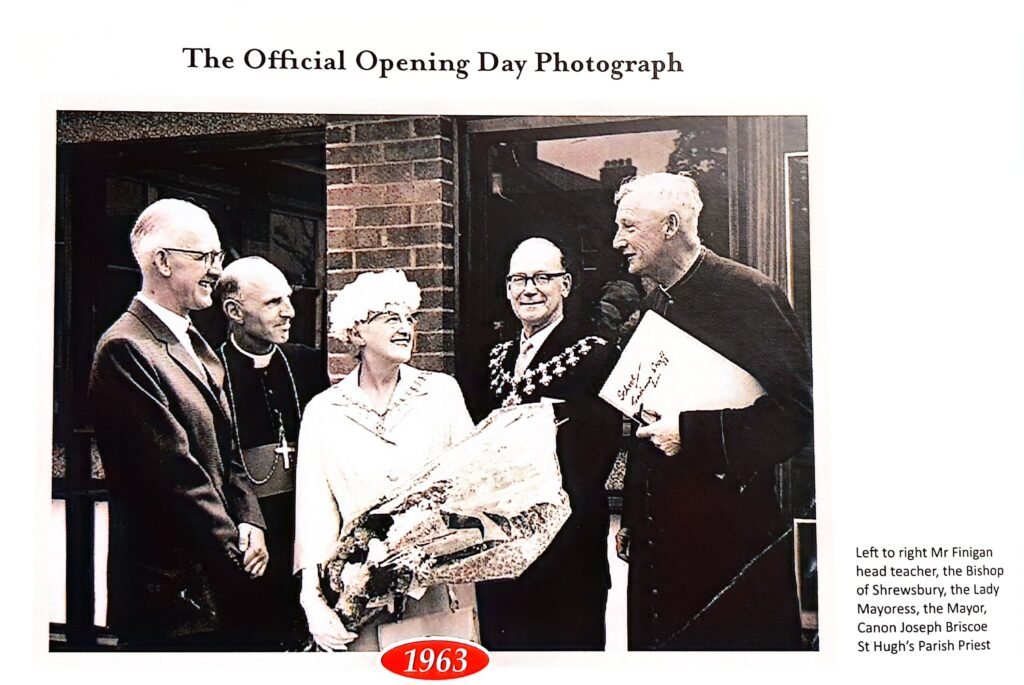
It had been hoped that the first headteacher of St Hugh’s single-form-entry School might be the lady who had prepared so many children for their First Sacraments and who had taught at St Vincent’s. Sadly however, this lady passed away before this could happen, and in her memory, her parents donated a statue of St Hugh to the parish .
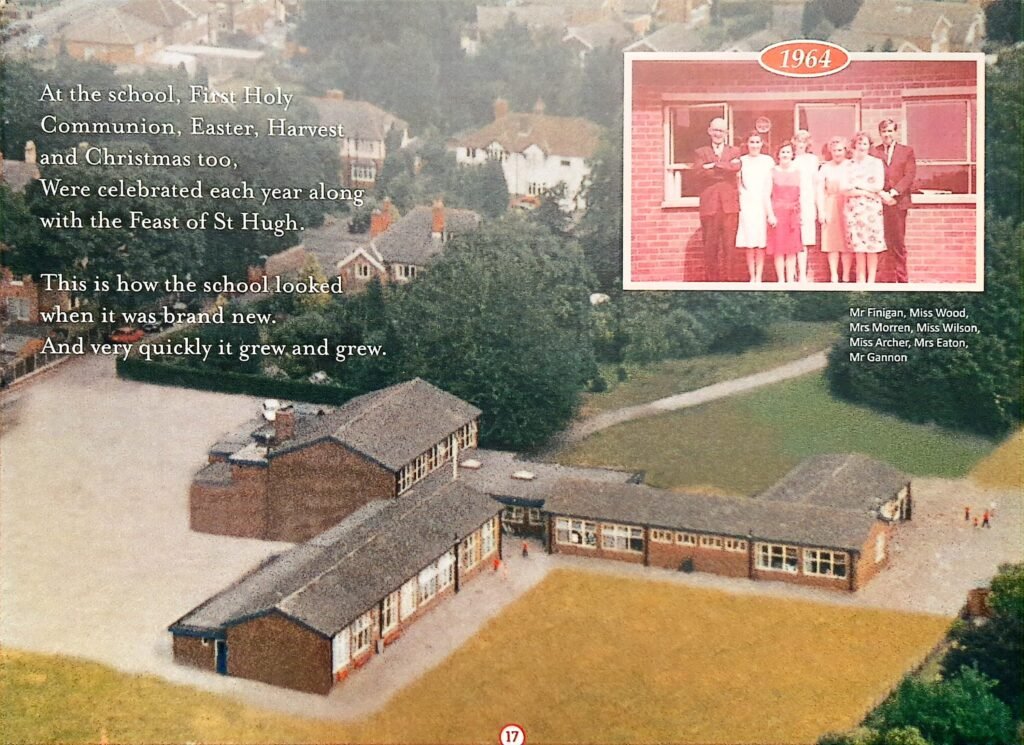
It was placed in the church near the entrance to the sacristy, and was soberly dressed in brown and accompanied by a rather grey-looking swan.
During the previous year of 1962 a large house adjacent to St Hugh’s Church, Abbotsford Lodge, came on the market. Father Briscoe set about obtaining it, for his dreamed-of new church, and in August it was successfully purchased, though for a higher price than originally expected, because of the land’s potential for housing. Planning began, and planning permission sought, but it all took a very long time indeed. After all the post-war developments, money was tight. The land was used for parking during this period of waiting. Obviously, the age of the motor car had arrived!
In 1970, in the wake of Vatican II, the old St Hugh’s “temporary” church was modified to meet the requirements of the new reforms. The high altar was brought forward and a new tabernacle installed. Meanwhile the need for new churches continued, because of yet further housing being built, this time in the shape of the Racecourse Estate in Sale West. To meet this need, in 1974, a new school and pastoral and Mass centre was established on Cherry Lane, and dedicated to St Margaret Ward. It stood between the parishes of St Hugh and All Saints, Sale; but it was not a church and no changes were made at that time to the parish boundaries.
Some time later, Canon Joseph Briscoe fell ill and was taken to hospital. In his absence the parish was cared for by Father O’Doherty, an assistant priest. Father Briscoe was expected to return to the parish, but it was not to be. After 26 years as parish priest of St Hugh’s, he passed away in 1978.
His funeral was huge and memorable. It was attended by one archbishop, four bishops, and 92 priests. St Hugh’s Church was overwhelmed and loudspeakers had to be installed for the benefit of all the parishioners unable to enter the church, who overflowed into the car park.
Father Michael Dyson

In 1978 Father Dyson became the new parish priest of St Hugh’s, and was immediately acutely aware of the disappointment in the parish at the fact that their so-called “stop-gap” church, expected to serve the parish for ten years, had now been their church for over forty. He was undaunted. An energetic man, with an equally energetic Dalmatian dog called Oscar, he began to turn the church upside down, bringing a new sense of cheer to his parishioners.
He changed the rather dry weekly news-sheet into a 4-page publication, complete with humorous items. He acquired a second dog as boisterous as the first and could be seen frequently walking to St Hugh’s School, with the dogs dressed in school ties and caps! He instituted a Teddy Bears’ Picnic, announced with great humour in the newsletter. The Young Wives’ group began their activities on his watch. Between their pouring teas and washing up at parish functions, they had very lively garden parties on the presbytery lawn, with Father Dyson presiding over the mixing of Sangria. On one occasion, the young husbands had to come with wheelbarrows to take all their young wives home! The group continued to thrive, however, until it became necessary to remove the word “Young” from their name.
Father Dyson brought guitars and rock music into the church – to a somewhat mixed reception. He held a Folk Mass, and a Folk Group was established. So also was the choir known as the Lincoln Singers, well-remembered by many parishioners today. They performed in several different venues, and continued to do so until their ultimate disbandment, in 1992. The Lincoln Singers often practised in Wyncourt, a large house further down Park Road. Why? For the best of reasons. The meeting hall had been demolished to make way at last for a new church.
Some time had been spent, after that big funeral when so many parishioners had had to stand outside, considering extending the old church. But eventually the expense, and the inconvenience of having to hold Masses elsewhere during the period of its construction changed minds, turning them towards the plan for an entirely new building. On his visitation to the parish, Bishop Brewer agreed to this. To offset the large expense, it was proposed to sell off some of the Abbotsford Lodge land for development, perhaps to provide about thirty homes for the elderly.
In 1979 it was officially announced that a new church was to be built. The old church would be changed into a Parish Centre. It took a further year to finalise the design, described as “a pyramid roof built on a perfect square, supported by four beams from the corners … the beams becoming part of the design … emphasised by the pitch-pine roof.” The architect was Anthony Bean, and the church purpose-built to suit the changes brought by Vatican II. The tabernacle would be to one side, balanced by a Lady Altar on the opposite side.
In 1980 the final plans were viewed and approved by 130 parishioners in the school hall. This time the plans for the church soon received their planning permission, but that for the housing development was endlessly deferred, despite the three-storey development being modified to two-storey, with a loss of a number of flats. £600 had to be paid for an indemnity policy to get over a belatedly-discovered covenant on the land.
Building began on the 2nd of February 1981. There was considerable debate over fixtures and furnishings, more fundraising (eliciting generous donations), and the sponsoring of various items by parishioners. In appreciation of this generosity, Father Dyson had the benefactors’ names recorded in a “Liber Vitae” or Book of Life which would be placed in the Lady Chapel of the finished church.
The Church’s foundation stone was laid by Bishop Joseph Gray on May 24th 1981. On the 13th of December of that same year, the church was opened with a Service of Dedication held in and for the new St Hugh’s Church. The date coincided with the worst snow-storm of the winter. The service took place in a blizzard. Bishop Gray was assisted by the helpful Bishop Brewer, 50 years to the day since the opening of the old church in 1931. That “stop-gap” church, built to last 10 years, had served West Timperley for 50 years!
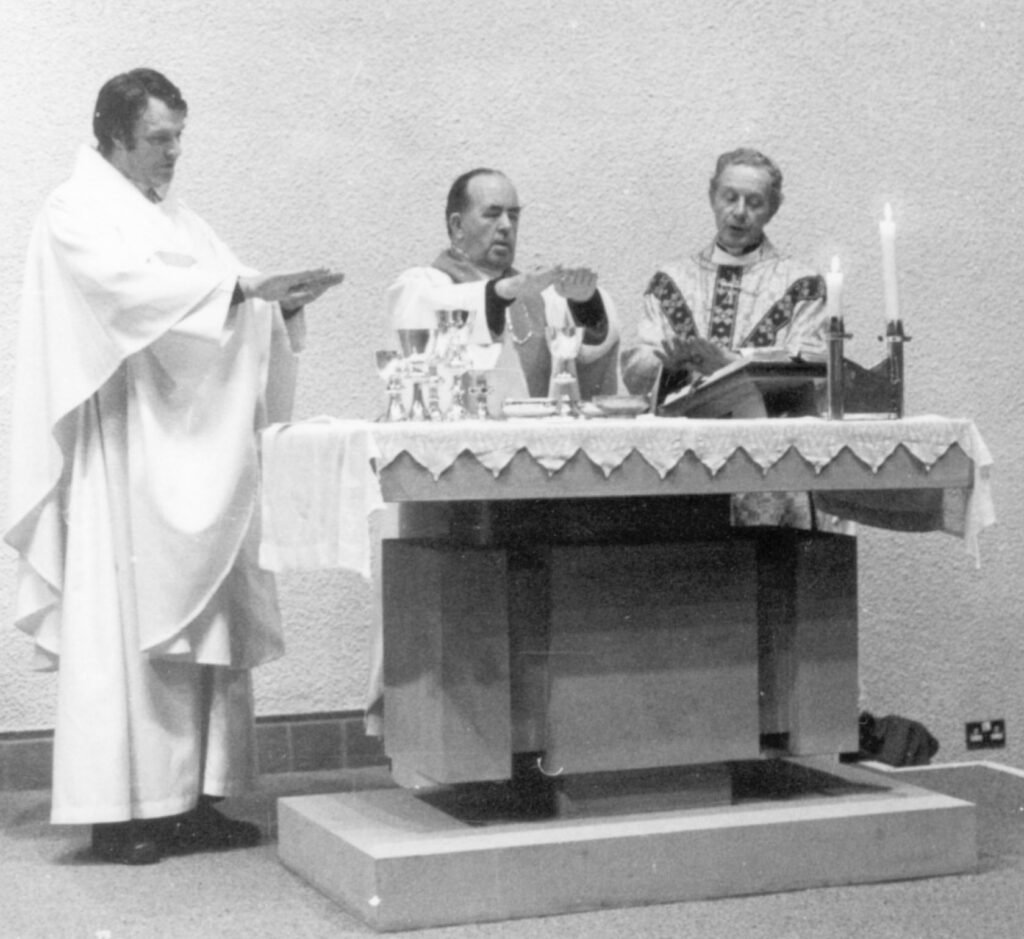
After a long struggle to bring it to fruition, the sheltered housing scheme on the adjacent land was abandoned. The land was sold to a developer, and became St Hugh’s Close. The old church was turned into a parish centre on a tight budget and with a great deal of voluntary help.
In 1983 St Margaret Ward became established as a parish in its own right, taking in portions of the parishes of St Hugh’s and All Saints, Sale.
Once parishioners had begun to worship in their new church, they realised the need for some changes. The small organ originally thought suitable was found not to fit well in the church, the layout of the benches was altered to provide side aisles, and the loft was boarded to provide storage space. The tiled plinth for the tabernacle was encased in wood with the carved head of Christ on the front panel, rather than on the wall behind. Carpet was laid over the quarry tiles, to deaden noise and make cleaning easier.
In general, however, the church building proved a great success. It was the right size for its congregation, and had no pillars to obstruct views or routes back from receiving Communion. It was much easier to heat and to clean than a great many churches. It was discovered to have excellent acoustics and was popular with choirs for their rehearsals, concerts and even some recording sessions. At this stage, however, it had a very narrow porch, which was effectively cut in two when the inner doors were open.
Father Denis Maher
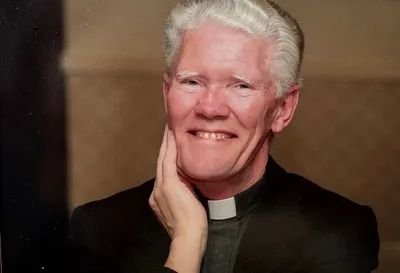
In 1986, when Father Dyson was transferred to another parish, Father Denis Maher became the new parish priest of St Hugh’s. An ex-boxer, Fr Maher arrived to face another kind of fight – with the state of the parish finances. Despite these problems, however, he introduced more changes to the church, replacing the small organ with a new electronic one (joined now by an electronic piano), and augmenting the lighting to the side aisles, as well as having skylights installed in the roof to save on lighting costs.
In the same year as his arrival in the parish, an extremely generous bequest was left to the church in the will of John Blyth, a gentleman whose written account of St Hugh’s early church history added much to this account, as it did to an earlier one compiled in 2006. Thanks to his posthumous generosity, a statue of the Risen Christ was purchased. Although slightly controversial, because it was not a traditional crucifix, the statue was installed and still hangs high on the wall behind the main altar.
Father Maher, like others before him, proved to be a great fundraiser. He disbanded some costly things, like the Social Club, because of the expense of the licence, the pay of a full-time steward, and the necessary updating of toilet and catering facilities; but he raised money in various ways including a Grand Raffle of a car. As a result of his and parishioners’ efforts, the debt accumulated by all the building and development work was speedily cleared and the parish placed on a sound financial footing.
Despite the demise of the Social Club, the parish hall was still well used by groups like the UCM, the Lincoln singers, Brownies and the Tuesday Group. This latter provided weekly meetings for pensioners with chat, talks, activities, occasional trips to places of interest and annual coach holidays. The hall also housed coffee mornings, an annual senior parishioners’ meal, and could be hired for family celebrations.
The liturgical part of church life was vibrant in the time of Father Denis Maher. He had a free bus to church organised with the help of the Stamford Hire company, enthused his congregation, and had to put on an extra Mass to cope with an increase in attendance. Father Denis brought a unique style to his sermons, choosing to deliver them unscripted, and from the body of the church. They were always lively and illustrated with humour and stories of which he had an endless supply. He would invite comments from the congregation and occasionally question someone he thought was not paying attention, which created much laughter.
He also led a successful pilgrimage to the Holy Land and took a small group to Rome where they attended Mass in celebration of the English Martyrs.
Father Denis Maher had his own difficulties and family tragedies to cope with, but more lay ahead. When, after serving the parish of St Hugh for ten years, he was transferred in 1996 to a parish in Hyde, he arrived there only a few days before the Harold Shipman murder scandal in that town became public knowledge. It must have meant a huge surge in pastoral care.
Father Anthony Myers

Father Tony Myers took up the role of parish priest here in 1996 and was to serve until 2017, a total of twenty one years. They proved to be years of considerable change; though the first changes were modest. He introduced Days of Recollection for Ministers of the Eucharist, and oversaw the start of the parish Toddler Group.
Becoming aware of the problems with the church’s narrow porch, Father Tony obtained permission in the year 2000 to extend the porch (or narthex) outwards, making a much bigger space and incorporating facilities for the disabled, and for baby-changing. This successfully created a light and spacious area which has proved extremely useful for all kinds of meetings as well as for information display, and the piety stall.
The statue of St Hugh, brought into the new church when it was founded, was still looking rather drab. So the helpful parishioner who had re-gilded the Stations of the Cross, set to work in 2001 repainting him and giving him a robe of bright red, with a rejuvenated white swan. He surveyed the congregation from a position high above the church’s entrance doors. Father Tony also had the old stone font from the original St Hugh’s Church adapted and turned into a fountain outside the doors of the new church. It still stands there, though sadly it is no longer a fountain today.
The year 2006 marked the 25th Anniversary of the Founding of the new St Hugh’s Church, and the 75th Anniversary of the original (temporary!) church. There were great celebrations including a parish pilgrimage to Lincoln, a picnic in Tatton Park, a parish barbecue, and the publication of a recipe book – a runaway success! – as well as the publication of a parish history (to which this one is much indebted).
[Fr Tony’s story continues, but we need at this point to catch up on what was happening in Timperley Village at St John the Baptist.]
ST JOHN THE BAPTIST PARISH
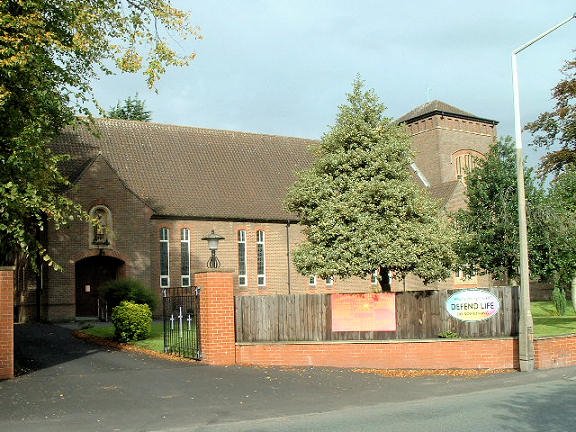
Father Joseph Taggart
The opening of this church in 1960 with Father Joseph Taggart as its parish priest has already been mentioned above. Father Taggart had been appointed to the parish three years before the opening and was responsible for the building of this Church, designed by Francis Reynolds and boasting attractive side altars and a separate baptistry with a striking mosaic of the Baptism of Christ.
Father Joseph remained in charge for a further seven years until he was transferred to Benchill in 1967.
Father Alfred McNally
In 1967 Father McNally exchanged places with Father Taggart, coming from Benchill to Timperley to the parish of St John the Baptist. Father McNally’s health was poor, and this was thought to be a more suitable parish for him. Despite the limitations of his state of health, however, he was given charge of the Vocations Team for the Diocese. He became a Canon in 1978.
Sadly, a request for permission to retire was refused. One night in 1981, just as he was about to go upstairs for the night he collapsed and died.
Father Ivor Kind
Father Kind was simultaneously transferred from Benchill to this parish along with Father McNally, and the two priests served together here for fourteen years from 1967 to 1981.
Father Kind had a range of talents. He was an excellent musician and organist, and he had also produced a beautiful brochure back in 1938 for the centenary of Oscott College. Unfortunately he too suffered from a difficult health condition, and the later years of his pastoral life were under the care of Canon McNally.
He remained as parish priest at St John the Baptist for several months after Canon McNally’s death, but on the arrival of Father Denis Herlihy, he took retirement in late 1981 and moved to West Kirby.
Father Denis Herlihy
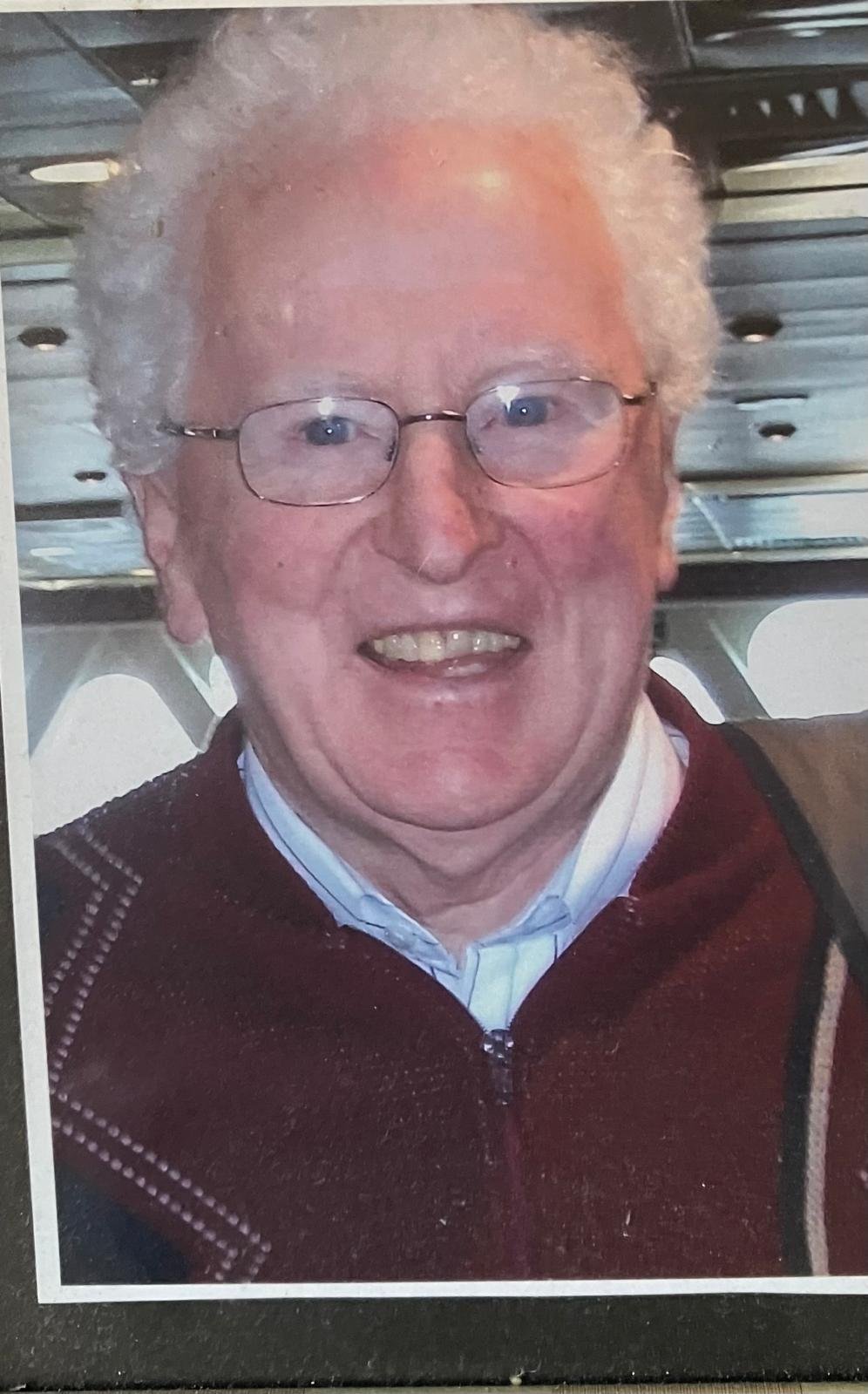
Father Denis Herlihy, an Irish man from County Cork, arrived in St John the Baptist Parish in 1981 and was to stay for 27 years. In his youth in Ireland he had been a formidable hurler. Not an ostentatious priest, Father Denis had a special closeness to the Holy Spirit after an introduction to the Charismatic aspect of the church in the late nineteen-seventies.
During his time at St John’s he introduced Life in the Spirit Seminars which gave rise to a number of prayer groups as well as Healing Services. He gathered all the prayer groups together for a monthly parish prayer meeting in the choir loft of the church. One of these, the Living Waters Prayer Group, founded in 1986, is still running in the porch of the Church of St Hugh and St John today. Father Denis took groups to Medjugorje, a site of Marian apparitions, as well as leading groups as large as a hundred to the New Dawn Conferences held each August in Walsingham, Norfolk.
The church lacked a sizeable hall, of course, so tea and coffee gatherings after Mass, as well as various meetings were crammed into the presbytery. Nonetheless, an annual Garden Party was held very successfully on the large lawn at the rear of the house thanks to the prodigious efforts of parishioners, and an annual Christmas Dinner for the over-sixties took place in Christ Church Hall, over on the other side of Shaftesbury Avenue, on the corner of Thorley Lane and Mainwood Road. Days of Recollection were held for Ministers of the Eucharist. On alternate years these took the form of full away days at centres like Katherine House in Salford, and on the other years they were half-days in the presbytery with a visiting priest or deacon to lead.
Father Herlihy may have seemed very modern to some, but he stuck by the practice of having only boys as altar servers. Father Denis supported Youth 2000, and served as Chair of Shrewsbury Justice and Peace commission.
Having experienced a period of “burn-out” from trying to do too much early in his time in Timperley, Fr Herlihy learned to take a weekly day off and became a keen golfer as well as a football supporter. He retired to Knutsford in 2008, though returning to his native land in 2011 where cancer sadly took his life in 2012.
Father Maurice Abbott
Father Abbott resided at St John the Baptist from 1981 to 1984, serving as assistant priest. Diocesan Archivist for a number of years, Father Maurice was a historian and as well as editing the Diocesan Yearbook for some years, was the author (amongst other things) of Centenary Record: Diocese of Shrewsbury1850-1986, and a History of St Joseph’s, Sale. Father Abbott died in 2004.
THE PARISH OF ST HUGH AND ST JOHN
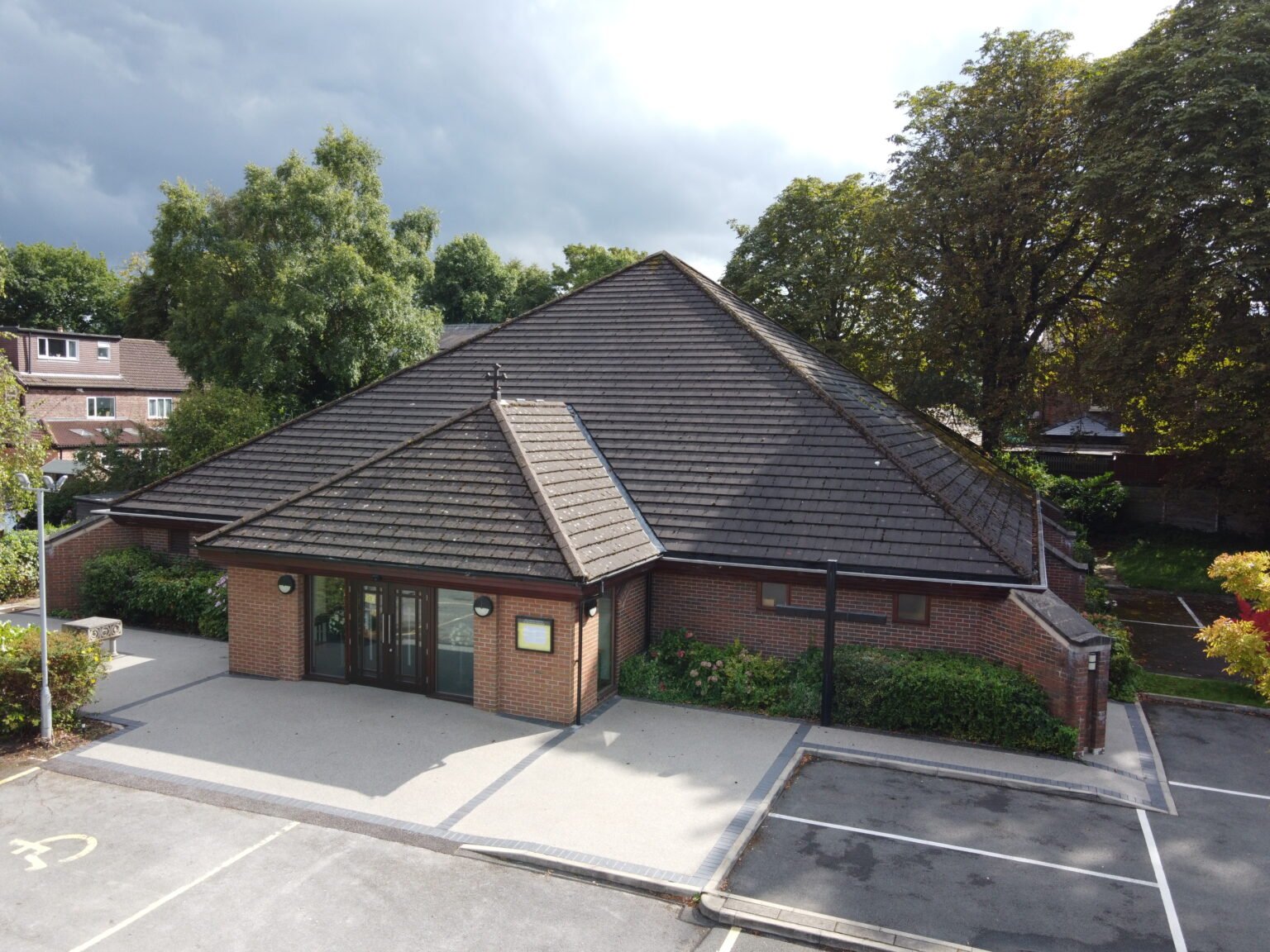
Father Anthony Myers (contd.)

The retirement of Father Denis Herlihy heralded big changes. Shrewsbury Diocese had for some time had provisional plans for this parish to be re-amalgamated with St Hugh’s if and when the need arose. At this point in time, with diminishing church attendance, a shortage of priests and the increasing costs of maintaining a very large number of church buildings, the diocese decided that this time had come. The church closed after a final Mass on Trinity Sunday, the 7th of June in 2009, after serving its parish for 49 years. The two Timperley parishes were reunited and renamed the Parish of St Hugh and St John. Father Tony Myers found himself responsible for a suddenly larger parish.
For eighteen months, as a result of pleas from the parishioners, it was agreed with Bishop Brian Noble that the Presbytery at St John the Baptist should be retained to serve as what used to be called a “Chapel of Ease”. One of the front rooms was adapted as a chapel, and the statue of the Virgin and Child was placed in the spacious entrance hall. Father Tony visited each Thursday, to celebrate Mass in the chapel. In this way reserved Sacrament was available to be taken to the sick and housebound in the Village and Broomwood areas. Parishioners held daily Adoration and some services of the Word and Communion during the week. On Sundays parishioners went to Holy Mass in St Hugh’s, with the exception of some who lived nearer to other churches in Baguley, Hale Barns or Altrincham and chose to go there. Prayer group meetings and other devotions continued in the old presbytery also. Dreams of building up the centre as a retreat house, however, were to be sadly dashed.
After Bishop Mark Davies was installed as Bishop of Shrewsbury in 2010, a new financial review of the situation was undertaken and resulted in the Bishop meeting with parishioners to explain that it was now proving necessary to sell the entire site of St John the Baptist, church and presbytery together. Activities in the old presbytery came to an end in November 2010. There was a considerable delay in the selling of the site, but eventually the church and house were demolished in 2013 and the site purchased by Churchill Homes who built a large development of retirement apartments there, calling it, in a thoughtful gesture and at a parishioner’s request, St John’s Lodge. It opened in 2015.
Meanwhile, the St Hugh’s parish centre, still sited in the old “temporary” church building, was in a serious state of disrepair, and a new building was urgently required. The sale of St John the Baptist church site helped to provide the means for a new parish centre to be built, and plans for this were soon being discussed.
In March 2015, a large part of the car park was fenced off and the old building demolished to make way for the new one to be built. It had also been decided to build a small development of two retirement apartments for priests between the church and the presbytery. Father Tony, therefore, not only had a much larger parish, but a major building programme on his hands. The new Parish Centre was opened in spring 2016.
It boasts a strikingly high-roofed and spacious main hall, which hosts Scouts, Guides, a playgroup and various church activities like Sunday coffee gatherings after Mass. In its meeting room can be found the foundation stone from the demolished St John the Baptist Church in Timperley Village. It was brought here and stored for a while in the boiler room, before being installed as a memorial of the union of the two parishes. By this time also, the beautiful wooden statue of The Virgin and Child, which had lived for a while in the hall of the St John the Baptist presbytery, was installed in the Lady Chapel, to the left of the Sanctuary, in the Church of St Hugh and St John.
Father Tony Myers retired in 2017, but remained not far away in Knutsford.
Father Patrick Munroe…
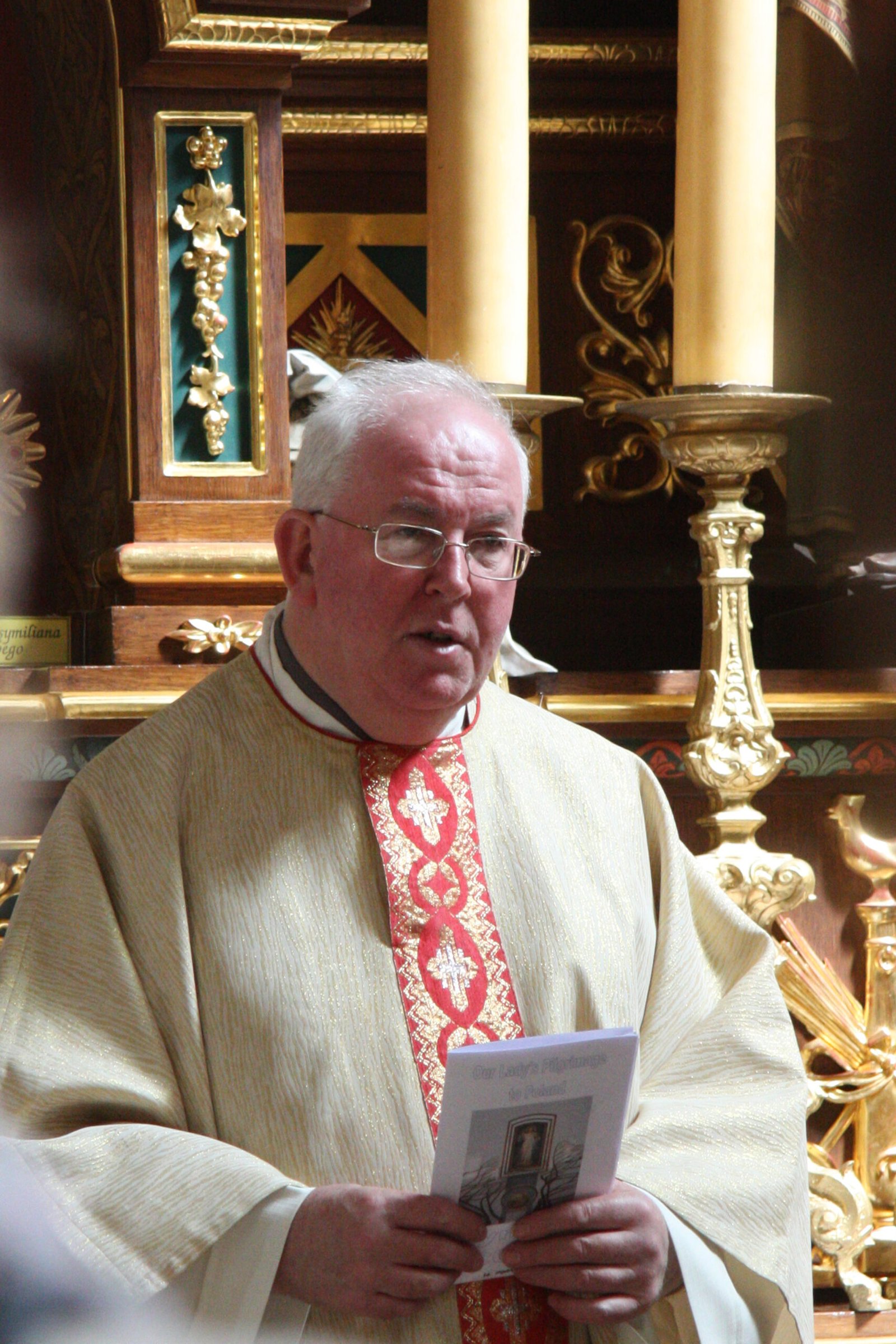
Father Pat Munroe came to the parish of St Hugh and St John from Stockport in March 2017. An affable Irishman, he soon showed a great talent for remembering everyone’s names and a concern for all aspects of parish life. Father Pat was (and still is!) a frequent visitor to Lourdes and served many years as Chaplain to the sick during the Diocesan Annual Pilgrimages. There is a certain irony to this, as after his first two years in this parish, in February 2019, Father Pat most unfortunately suffered a stroke and needed hospital care.
The parish had a number of visiting and temporary priests in the next months (including Father Myers) whilst Father Pat recovered. Sadly, his illness left him with some physical disabilities, though on his return it soon became apparent that his mind and spirit were as strong and wise as ever. Some aspects of a parish priest’s duties, however, were impossible for Father Pat to perform despite his strong wish to do so. A great many prayers were offered for Father Pat’s total recovery, but it was not to be. His pilgrimages to Lourdes became no longer ones in the role of one assisting, but of one being assisted.
...and Father Tomasz Mamelka
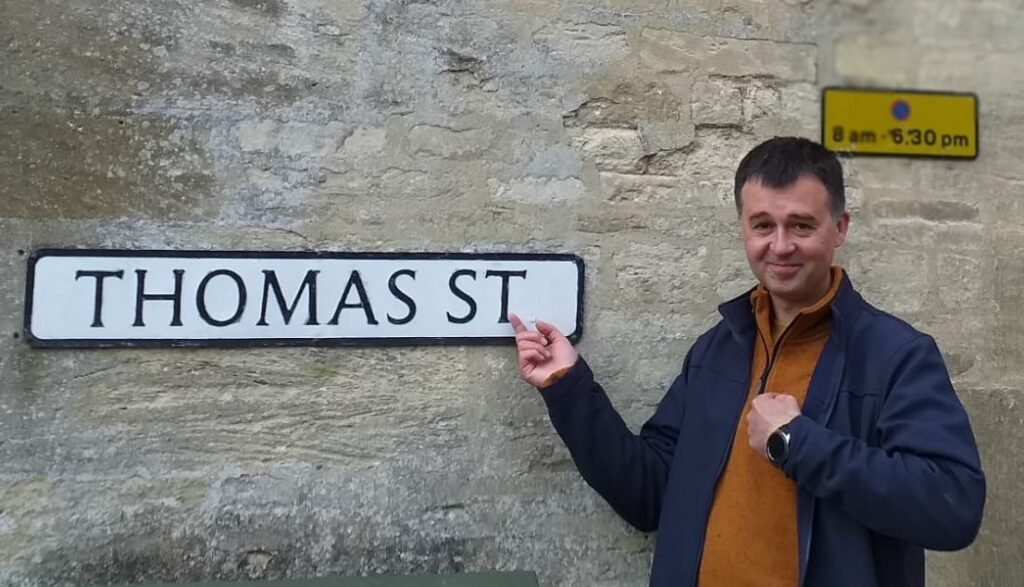
It was a great blessing for the parish, therefore, when in the September of 2019, Father Tomasz arrived from the Archdiocese of Szczecin in Poland to serve as Priest in Charge. He had worked with Father Pat previously for a year in Stockport, and knew him well, and had also long harboured a desire to come from Poland to work in the UK, preferably in the Shrewsbury Diocese. His arrival enabled Father Pat to continue the work he loved, and the parish of St Hugh and St John was gifted with a remarkable team of priests, who seemed to fit each other’s needs perfectly, though their ages and temperaments differed. They are a living parable of human cooperation.
In 2020, of course, the pandemic of Covid-19 struck. By Easter time the church was closed and we all had to learn a few more computer skills in order to participate in Masses and other church events online. It was a difficult time for everyone, although some of the housebound benefited by having Holy Mass live-streamed into their own homes for the first time.
Then there was a lengthy period of gradual return to church activities, with spaced seating arrangements, hand-gel everywhere, and lots of extra cleaners!
In 2021 there was also a refurbishment of the church, moving the tabernacle to the centre of the rear wall, widening the sanctuary, fitting new church doors and laying new carpets amongst many other things. In the side chapel which used to hold the tabernacle were placed the brightly re-painted statue of St Hugh and a newly-acquired dramatic statue of St John the Baptist. It was fortunate that the Parish Centre was now available, and it served as a temporary church until the refurbishment was completed.
Although Father Pat had become Canon Pat Munroe in 2020, he never encouraged the use of this title, and in 2022 he stepped down to the role of Assistant Priest, while Father Tomasz became the Parish Administrator (parish priest being a title unavailable to him whilst he remains under the authority of his Bishop in Poland).
The priests’ retirement flats are in full use now, with Father Pat living in one of them, and Father John Daly in the other. Fr John is very much a part of the parish, celebrating Mass frequently. So we are a most fortunate parish today, with a newly-refurbished church, a very substantial parish centre, large car park and, best of all, three priests.
We have come a long way from the days of the first chapel, created by parishioners out of two knocked-together rooms in the crumbling Timperley House!

